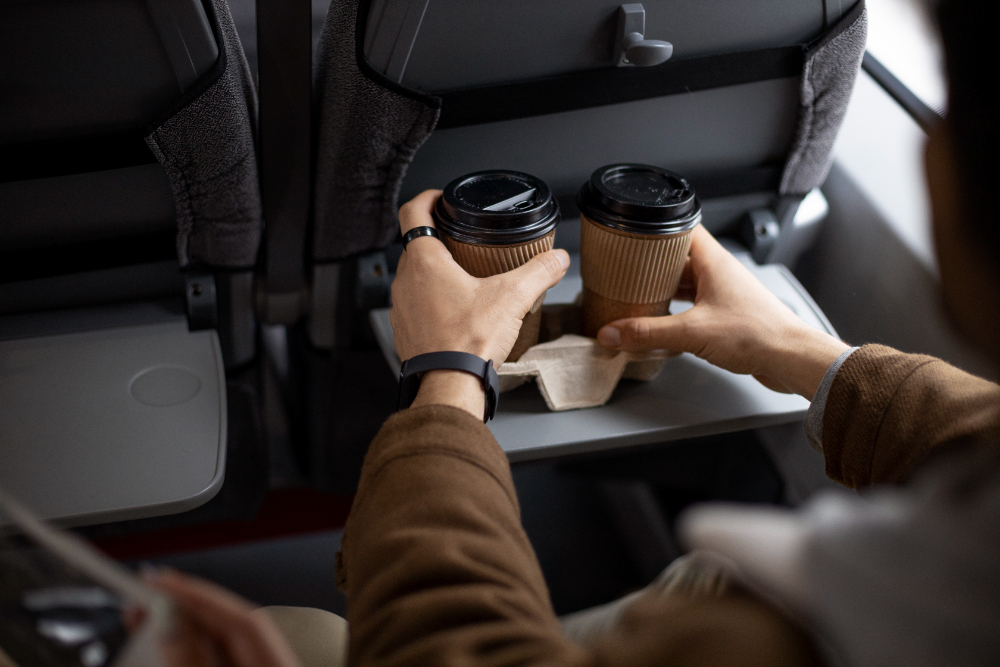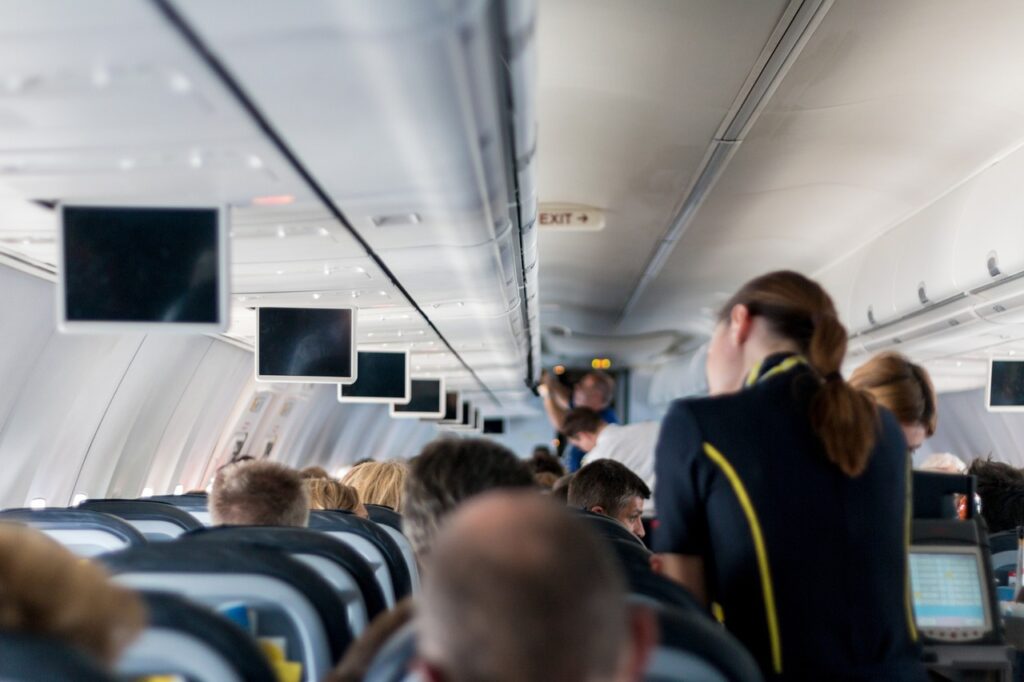Can you really take your iced coffee through security? Or sneak a water bottle onto the plane? When it comes to flying with drinks, the rules aren’t just about convenience—they’re about compliance.
From TSA’s infamous 3.4-ounce limit to the surprising risks of sipping your own mini liquor bottles mid-flight, air travel has some serious boundaries when it comes to beverages. This guide breaks down everything you need to know about bringing drinks on a plane—so you can stay hydrated, avoid fines, and breeze through security with zero drama.
TSA Liquid Rules for Bringing Drinks on a Plane

The TSA’s 3-1-1 rule is the gold standard when it comes to flying with liquids in your carry-on luggage. Simply put, you’re allowed to carry liquids in containers of 3.4 ounces (100 milliliters) or less, all packed into a single, quart-sized, clear, zip-top bag. This rule applies to toiletries, cosmetics, and yes—drinks.
That means any beverage you try to carry through the security checkpoint—water, juice, soda, or anything else in liquid form—must be in a container no larger than 3.4 ounces. Trying to bring a full-sized bottle, even if it’s factory sealed, will result in it being confiscated at the checkpoint.
Even partially filled containers over the 100 ml limit are not allowed. It’s the size of the container, not the amount of liquid in it, that matters. This applies whether you take drinks on a plane from home or buy them before arriving at the airport.
If you forget this rule and try to bring a drink on a plane that exceeds the limit, TSA agents will simply throw it out. No exceptions are made for personal preference or cost. The safest bet? Pack an empty reusable bottle and fill it once you’re past security.
Knowing these limitations before you pack can help you move smoothly through screening and avoid unnecessary delays or waste. It’s also a good moment to review what is allowed in a carry-on bag, as liquid rules are just one part of a broader set of restrictions that affect what you can bring on board.
Can You Bring Water, Juice, or Other Drinks from Home on a Plane?
Bringing your favorite beverage from home might seem like a simple way to stay hydrated or save money, but it comes with strict limitations. Any drink you carry from home is subject to the TSA 3-1-1 liquid rule. This means you can only bring liquids in containers of 3.4 ounces (100 ml) or less, and they must fit inside a single quart-sized, transparent plastic bag.
So, if you’re hoping to bring a bottle of water, a sports drink, or even a smoothie through security, it’s not going to make it past the checkpoint unless it’s in a tiny travel-sized bottle. Even sealed store-bought beverages over 100 ml will be tossed by TSA officers.
The smarter solution? Pack an empty water bottle in your carry on baggage. Most airports now have water refill stations past security, allowing you to fill up before boarding. This not only helps you stay hydrated but also saves you from paying inflated airport drink prices.
Whether it’s juice, flavored water, or herbal tea, the same rule applies. To bring drinks on a plane, the key is either to keep them small—or bring them empty. This becomes even more important if your trip includes a flight layover, where you might face additional screening at your connecting airport.
Exemptions to the 3-1-1 Rule TSA

While the 3-1-1 rule is strict, there are important exceptions for passengers traveling with specific needs. The TSA allows larger quantities of liquids when they are medically necessary or required for infants or small children.
This includes:
- 🍼 Breast milk and infant formula
- 💊 Liquid medications
- 💧 Medical liquids like saline or nutritional supplements
These items do not need to fit in the quart-sized bag and can exceed the 100 ml limit, but you must declare them at the checkpoint. TSA agents may ask to inspect or test the liquids, but you will be allowed to take them on board after the screening process.
It’s a good idea to keep these items clearly labeled and easily accessible, and to bring supporting documentation (like a prescription or doctor’s note) if you feel it’s necessary.
These exemptions are essential for passengers with medical needs and families traveling with babies, ensuring they can take drinks on a plane that are critical for health and comfort—without stress or confusion at security.
Can You Bring Drinks Purchased at the Airport?
Yes, once you’ve cleared security, you can bring drinks on a plane that you’ve purchased inside the airport terminal. Beverages bought at airport shops, restaurants, or cafes after the security checkpoint are not restricted by the TSA’s 3-1-1 rule. That means you can carry a full-sized bottle of water, juice, coffee, or soda onto the aircraft without issue.
This is the safest and easiest way to have a drink in hand before boarding. However, make sure the drink is sealed if you plan to take it through the gate area. In some cases—especially at international terminals—airport staff may perform additional checks at boarding, and unsealed drinks may not be allowed on the plane.
If you want to avoid the hassle of measuring ounces or worrying about container sizes, simply buy your drink after security. It’s the most convenient way to bring drinks on a plane after security without risking confiscation.
Can You Drink Your Own Alcohol On a Plane?
No—you cannot drink your own alcohol on a plane, even if you legally purchased it or brought it in mini bottles. According to FAA regulations, passengers are not allowed to consume personal alcohol during a flight, no matter how small the quantity.
You’re welcome to bring sealed mini bottles of alcohol in your carry on bag (within the TSA liquid limits), but they must remain unopened during the flight. Only flight attendants are permitted to serve alcohol, and all in-flight alcoholic beverages must come directly from the airline.
Breaking this rule is no small matter. If you’re caught trying to drink your own alcohol on a plane, you could face fines, legal consequences, or removal from the flight. In extreme cases, it could even lead to denied boarding on future flights with the same airline. So what is the fine for drinking your own alcohol on a plane? It can reach up to $40,000, depending on the severity of the violation and its impact on flight safety.
If you’re looking to relax before takeoff, grab a drink at an airport bar or lounge. Once onboard, you can order wine, beer, or cocktails—but only if served by the crew. The rule may seem strict, but it’s there to ensure safety and order in the cabin at all times.
Differences in Liquid Rules for International Versus Domestic Flights
When flying within the U.S., the TSA 3-1-1 rule is your standard: liquids must be in containers no larger than 3.4 ounces (100 ml) and fit into one quart-sized transparent bag. This rule applies to all domestic flights, whether you’re flying from New York to Los Angeles or Chicago to Miami.
However, when traveling internationally, things can get more complicated. While many countries follow similar guidelines—especially those with major airports in Europe, Canada, and Asia—not all enforce them in the same way. For example, some airports might have stricter screening procedures, while others may allow duty-free liquids under different conditions.
If your trip involves connecting flights or transit through multiple countries, be especially careful. A drink you purchase at one airport may be confiscated during a security recheck in another country. This often happens during layovers, where you must pass through a second round of screening before boarding your next flight. Even if the beverage was allowed at your departure point, it might not meet the liquid rules at the transfer airport. Additional screening can delay you and even cause you to miss your connecting flight, so it’s essential to plan carefully and avoid bringing drinks that could trigger extra checks.
Additionally, some regions impose limits not just on liquids in carry-ons, but also on what can be brought into the country, especially alcohol or perishable liquids. Always review both the departure and destination country’s regulations before you fly.
So while you can bring drinks on a plane under TSA rules for domestic travel, international flights may require more research and planning. Always check the latest liquid restrictions on your airline’s website or the airport authority of your destination. This helps avoid the frustration of having your items tossed during a layover or arrival screening.
FAQ
If your drink exceeds the 3.4 oz (100 ml) limit or isn’t packed properly, TSA will confiscate it at the checkpoint. No exceptions are made, even for sealed store-bought drinks.
Yes. Drinks with very high alcohol content (over 70% ABV), like grain alcohol or some spirits, are not allowed in carry-on or checked baggage.
FAA regulations prohibit it for safety and security reasons. Only flight attendants can serve alcohol on board. Trying to drink your own alcohol on a plane could result in fines or removal.
Yes, but only if they’re purchased after security. You can bring closed drinks on a plane from airport shops or cafes without volume limits.
